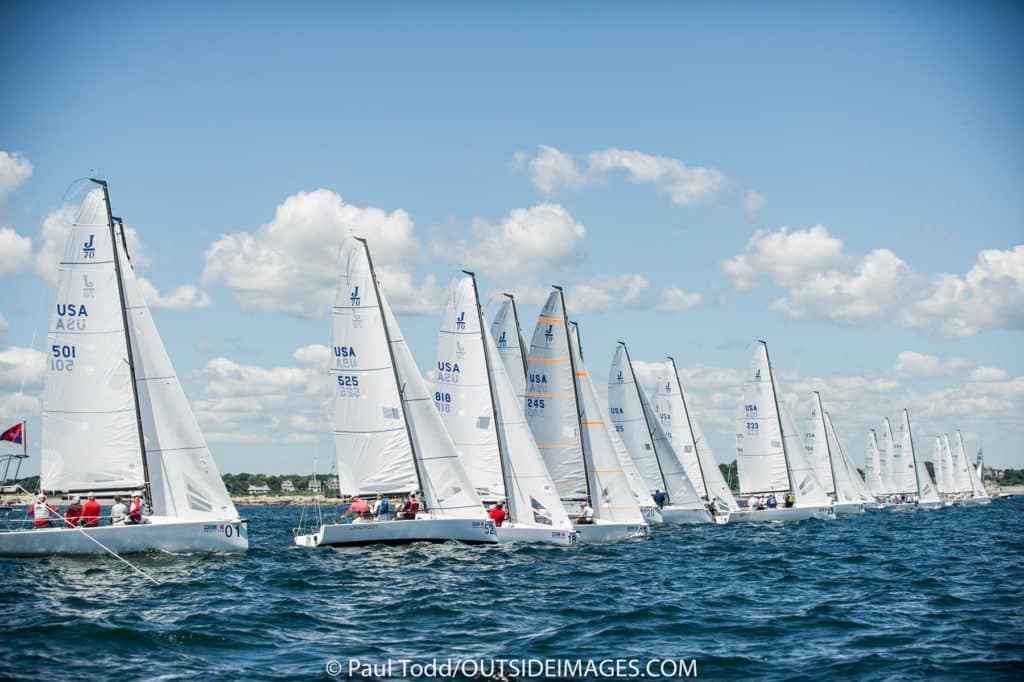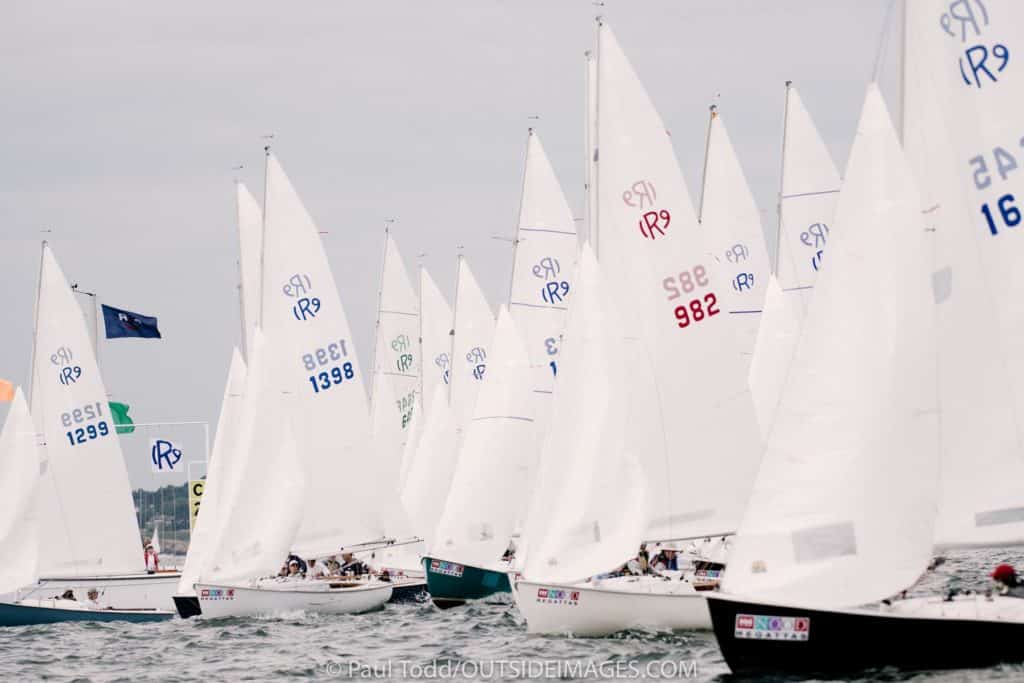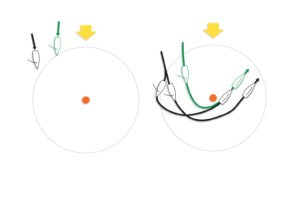
Everyone’s starting strategy should be a combination of their regular routine and an awareness of the conditions. And while it’s important for sailors to go through their pre-race routine (i.e. finding out which end of the line is favored, which side of the racecourse is favored, and how to balance the risks against the rewards in order to have the highest percentage start), it is just as critical to take into account current as well. Current will affect your approach to the line and ultimately your start of every race.
The Carpet Ride
When the current is pushing you upwind, we refer to it as fair current. Fair current is especially common in tidal zones and rivers where the breeze may come from a different direction on different days, and even different hours of the day. The moving water can accentuate the chop on the surface, and your otherwise well-timed final approach to the starting line may happen faster than you expect (or desire). One quick reminder: when you’re tuning upwind before the start in fair current make sure you leave enough time to get back to the starting area. It’s easy to forget how much longer it will take against the current.
When there’s fair current, expect the start to have a mid-line bulge. It’s easy to lose track of the starting line when you’re in the middle of the pack, and once you do, it can be difficult to compensate for current push on the final approach to the line. That’s why, in fair current, starting at an end is a low-risk strategy. Having a solid object you can use to judge the rate of your approach helps ensure you’re not OCS. Being bow-even with the pack in the middle of the line can be advantageous. If a pack is too aggressive, however, you will run the risk of an assertive race committee nabbing you.
A mid-line bulge can be problematic for race committees, so they most often immediately resort to penalty flags to keep everyone back from the line. Knowing your signal flags is the best way to make sure you get back to the line quickly after a general recall. Never return to the starting area until you get visual confirmation of the general recall flag or AP, and never rely on the sound signals; they’re only a courtesy.
Once the fleet starts to grasp how the current is affecting the start and the RC employs the appropriate penalties (e.g. India, Zulu, or black flags), it becomes more important to be bow-even with the pack, especially if you cannot see the race committee. Under a black flag, race committees will often write down any boats that were poked out early.
By hanging back early on and then accelerating earlier than the boats around you, you’re more likely to emerge clear. Once you’ve started your acceleration, however, realize that you’re committing yourself, so be careful! Often we trim in and accelerate too early, realize that we’re exposed, and then slow down. When this happens, the fair current continues to push us toward the line, but now we’re down-speed while everyone else is sheeting in for their final acceleration. Timing is everything in fair current.
Starting at the pin will be easier in fair current, because the laylines will rotate downwind. You can afford to sail deeper in the starting box and use the current to get your bow above the pin-boat. Conversely, starting at the boat is more difficult, and often we see boats stuck outside the boat-end because they didn’t account for the current compressing the fleet along the starting line.

Fighting the Flow
Downwind current, what we call foul current, will produce as many surprises as upwind current, but the surprises often become apparent only when it’s too late. The water moving downwind will create flatter conditions than normal, and the laylines will be further away than normal.
Mid-line sag is the most noticeable side effect. Boats that start at the ends have a distinct advantage over boats in the middle because they have easier references for the starting line. Often times, boats starting at the ends can be lengths ahead of boats starting in the middle. But with a good transit or line sight in hand, it’s possible to start in the middle of the line forward of the fleet and enjoy spectacular, open lanes in the middle of the course.
Don’t be afraid of getting your bow out ahead of boats on either side of you, because the current will impede your progress to the line, even if you’ve pulled the trigger too early. More importantly, many in the fleet will likely have a difficult time getting to the front row as the current pushes them away from the line. The first start of the day typically presents a lot of opportunity: recalls occur less often because sailors are often slow to accurately gauge the conditions. The race committee will likely start under the P flag, allowing for a more aggressive, bow-out approach.
Starting at the pin in foul current will be very difficult, because the layline gets increasingly thin. The pin’s anchor chain can be a snare trap for not only the pin-most boat in the fleet, but also its windward neighbors, as they all pinch to fetch the mark. Fighting the current is a losing battle, especially in a slow-moving pack, so think ahead.
Conversely, starting at the boat will become easier in foul current. Often times, being late at the boat can be a genius move as the fleet is pushed down away from the line. Boats waiting above the committee boat can easily swoop into the widening gap with great acceleration in the final seconds.
Sideways to the Current
When the current is flowing across the starting line from starboard to port, treat the scenario as if it were foul current. The committee boat end will be relatively open and the pin will be crowded thanks to the laylines shifting to shallower positions. It will take no time at all on starboard tack to get clear under the committee boat, so be patient. Setting up late outside the boat end might be a viable option if you want to promptly get to the right side of the racecourse. The pin end, however, will be getting closer even when you don’t want it to, so being proactive about starting farther from the pin will greatly reduce risk.
When the current is moving from port to starboard, treat the scenario as if it’s fair current. The committee boat end will be crowded, shutting out a lot of the regular traffic in that zone. The best plan is to establish yourself in a hole early because there will be a lot of boats squeezed out at the boat end looking for lanes down the line. On the other hand, the pin-end will be much easier to win because you can afford to get very deep in the starting box and still lay the anchor chain. This could be a great opportunity to win the pin with a late hook. The risk of a pin-end start is severely diminished as the current increases left to right across the line.
Pro Tips
1. Always do a current check as soon as you get to the racing area. In big breeze, you can see wind-drift current lines even on lakes or non-tidal situations.
2. Review local tide charts. Many local boat shops have detailed current maps broken down hourly. When it comes to current geography: Locals know best, so ask at the local bait shop, too.
3. History can be dangerous! Even with good local knowledge, the current will not be the same day-to-day or even year-to-year. For instance, if it rained for three days before the regatta, the incoming tide at the surface may be less as the rainwater ebbs.
4. Make sure the reading is worthwhile. Sail by the committee boat or the leeward mark and drop a current reference. A specially made stick, a sponge, or a full water bottle will work—the ideal device is something that sinks to the depth of your keel or centerboard, is not impacted by the wind, and is easily retrieved. Let the reference float unimpeded for a timed minute so you understand the distance and direction over time. I like to refer to current in boatlengths-per-minute so that we can better gauge the distance we need for our final approach in the last minute of the start.









